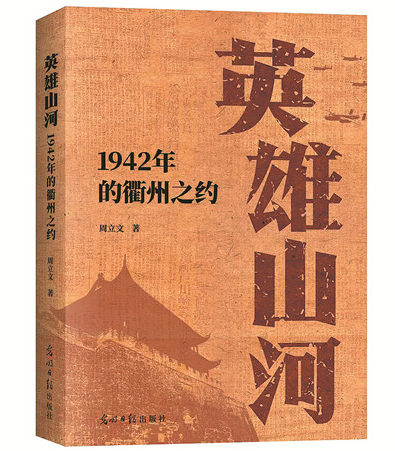


The forgotten acts of Chinese heroism

Zhou's nonfiction work Heroic Mountains and Rivers: Quzhou's Promise in 1942. [Photo provided to China Daily]
A recent nonfiction literary work has added a rare Chinese perspective to the already extensively documented Doolittle Raid during World War II, as it systematically restores the courageous efforts of Chinese civilians and military in rescuing United States pilots in eastern China following the raid.
On April 18, 1942, not long after the Pearl Harbor attack on Dec 7, 1941, Lieutenant Colonel James Doolittle of the US Air Force led 16 B-25 bombers in a daring takeoff from the aircraft carrier USS Hornet in the Western Pacific Ocean to launch a surprise attack on military and industrial targets in Japanese cities including Tokyo, Yokohama, Nagoya, Kobe and Osaka, an operation known as the Doolittle Raid.
This was the first Allied air raid on the Japanese mainland. However, the mission was prematurely exposed and conducted ahead of schedule. During their flights to China after the bombing, the planes encountered rain and communication breakdown in eastern China, which disrupted their original plan to land in Quzhou, western Zhejiang province.
Consequently, 15 aircraft crashed or made forced landings in an area of 500 square kilometers in parts of Zhejiang, Jiangxi, Anhui and Fujian provinces. Of the 75 pilots, 64 were rescued by Chinese people, three died during landing, and eight were captured by Japanese forces.
The scattered, rescued pilots were protected by Chinese civilians and military, who treated their wounds. They were gathered in Quzhou before being transferred to the rear areas of Chongqing, and Kunming, Southwest China's Yunnan province.
In his nonfiction work, Heroic Mountains and Rivers: Quzhou's Promise in 1942, journalist-turned-writer Zhou Liwen, 64, reviewed this section of history, focusing on the ordinary residents of eastern China who demonstrated bravery and sacrifice in the rescue. However, their contributions have long been overlooked.
During the book's launch event in Beijing on Aug 21, Zhou said the Doolittle Raid consisted of two phases: bombing Tokyo and landing in China. This was the first joint effort between China and the US in resisting Japanese aggression.
He added that although dozens of monographs on the Doolittle Raid have been published in the US, the second phase is rarely mentioned and when it is, the accounts are often incomplete and inaccurate due to insufficient materials and language barriers.
The rescue took place during the Chinese People's War of Resistance Against Japanese Aggression (1931-45), when parts of eastern China had been lost to Japanese occupation.
Many of these rescuers, encountering foreigners for the first time while on their way to school, cut grass, tend cattle, draw water from wells, or prepare breakfast, risked retaliation from the Japanese troops. An estimated 250,000 Chinese civilians were killed in Zhejiang and Jiangxi provinces following the raid.
According to Zhou, a former director of the local correspondents department of Guangming Daily, the book was written based on intensive reading of Chinese and American archives, as well as interviews with the descendants of the people involved.
From August 2024 to this February, he repeatedly visited the Memorial Hall to the Doolittle Raid in Quzhou, and the major plane crash sites and landing points of the pilots in cities such as Taizhou and Ningbo in Zhejiang and Shangrao in Jiangxi.
Traveling through the mountains and waters of the four provinces involved, Zhou was touched to see how the landscapes the heroes once protected remain intact and vivid, even though they themselves have passed away, which inspired the name of the book.
"I have largely abandoned grand narratives and instead focused more on scenes and details that highlight human nature," Zhou said, adding that while writing the book, he refused to fabricate any scenes or plots, use dialogue without a reliable source, or unrealistically elevate the characters.
Pan Jiankai, director of the Guangming Daily Press, the book's publisher, noted that from the initial stages of publishing, they made it clear that the heroic spirit and historical emotions must be presented completely and authentically. With reverence for history and respect for facts, they have ensured that the historical depictions remain true to reality and emotionally resonant.
Mei Jingzhong, a professor in the department of culture, literature, and history at the Party School of the Communist Party of China Central Committee (National Academy of Governance), said during the book launch that the book is based on solid historical research and features a smooth, lyrical style of writing, making it highly readable.
It combines valuable field investigations, meticulous archival research, and oral history compilations with vivid, moving details and scenes, creating a compelling group portrayal of the heroic figures, he added.
Editor:Yu Hui
Copyright©2023 CSSN All Rights Reserved